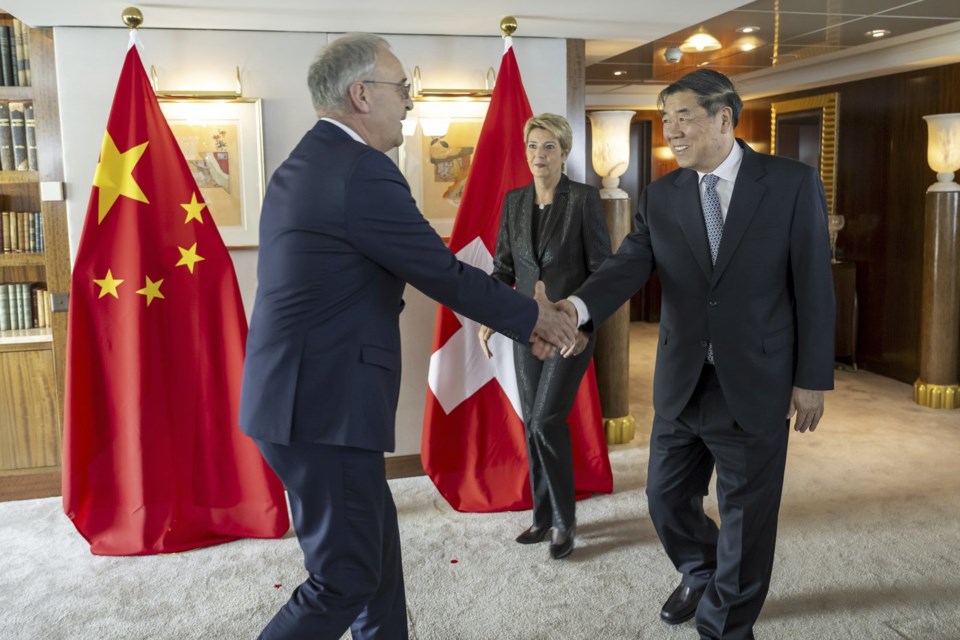GENEVA (AP) — The U.S. Treasury Secretary and America’s top trade negotiator began talks with high-ranking Chinese officials in Switzerland Saturday aiming to de-escalate a dispute that threatens to cut off trade between the world’s two biggest economies and damage the global economy.
Treasury Secretary Scott Bessent and U.S. Trade Representative Jamieson Greer have begun meetings in Geneva with a Chinese delegation led by Vice Premier He Lifeng.
Diplomats from both sides also confirmed that the talks have begun but spoke anonymously and the exact location of the talks wasn't made public. However, a motorcade of black cars and vans was seen coming and going from the home of the Swiss ambassador to the United Nations delegation in the wealthy city, and a diplomatic source, speaking on condition of anonymity because of the sensitivity of the meeting, said the sides met for about two hours before departing for a previously arranged luncheon.
Prospects for a major breakthrough appear dim. But there is hope that the two countries will scale back the massive taxes — tariffs — they’ve slapped on each other’s goods, a move that would relieve world financial markets and companies on both sides of the Pacific Ocean that depend on U.S.-China trade.
U.S. President Donald Trump last month raised U.S. tariffs on China , and China retaliated by hitting American imports with a 125% levy. Tariffs that high essentially amount to the countries’ boycotting each other’s products, disrupting trade that last year topped $660 billion.
Even before the talks began, Trump suggested Friday that the U.S. could lower its tariffs on China, saying in a Truth Social post that “ .″
Sun Yun, director of the China program at the Stimson Center, noted it will be the first time He and Bessent have talked. She doubts the Geneva meeting will produce any substantive results.
“The best scenario is for the two sides to agree to de-escalate on the ... tariffs at the same time,” she said, adding even a small reduction would send a positive signal. “It cannot just be words.”
Since returning to the White House in January, Trump has aggressively used tariffs as . He has, for example, from almost every country in the world.
But the fight with China has been the most intense. His tariffs on China include a 20% charge meant to pressure Beijing into doing more to stop the flow of the synthetic opioid fentanyl into the United States. The remaining 125% involve a dispute that dates back to Trump’s first term and comes atop tariffs he levied on China back then, which means the total tariffs on some Chinese goods can exceed 145%.
During Trump's first term, the U.S. alleged that China uses unfair tactics to give itself an edge in advanced technologies such as quantum computing and driverless cars. These include forcing U.S. and other foreign companies to hand over trade secrets in exchange for access to the Chinese market; using government money to subsidize domestic tech firms; and outright theft of sensitive technologies.
Those issues were never fully resolved. After nearly two years of negotiation, the United States and China reached a so-called Phase One agreement in January 2020. The U.S. agreed then not to go ahead with even higher tariffs on China, and Beijing agreed to buy more American products. The tough issues — such as China’s subsidies — were left for future negotiations.
But China didn’t come through with the promised purchases, partly because COVID-19 disrupted global commerce just after the Phase One truce was announced.
The fight over China's tech policy now resumes.
Trump is also agitated by America's massive trade deficit with China, which came to $263 billion last year.
In Switzerland Friday, Bessent and Greer also met with Swiss President Karin Keller-Sutter.
Trump last month to slap hefty 31% tariffs on Swiss goods -- more than the 20% levies he plastered on exports from European Union. For now, he's reduced those taxes to 10% but could raise them again.
The government in Bern is taking a cautious approach. But it has warned of the impact on crucial Swiss industries like watches, coffee capsules, cheese and chocolate.
“An increase in trade tensions is not in Switzerland’s interests. Countermeasures against U.S. tariff increases would entail costs for the Swiss economy, in particular by making imports from the USA more expensive,” the government said last week, adding that the executive branch “is therefore not planning to impose any countermeasures at the present time.”
The government said Swiss exports to the United States on Saturday were subject to an additional 10% tariff, and another 21% beginning Wednesday.
The United States is Switzerland’s second-biggest trading partner after the EU – the 27-member-country bloc that nearly surrounds the wealthy Alpine country of more than 9 million. U.S.-Swiss trade in goods and services has quadrupled over the last two decades, the government said.
The Swiss government said Switzerland abolished all industrial tariffs on Jan. 1 last year, meaning that 99% of all goods from the United States can be imported into Switzerland duty-free.
____
Wiseman and Tang reported from Washington.
Paul Wiseman, Didi Tang And Jamey Keaten, The Associated Press




